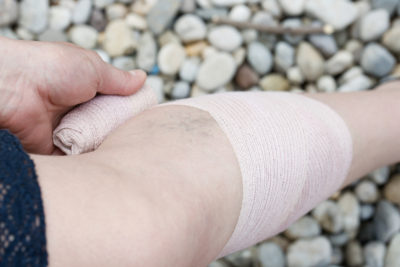 A common wound that demands quality care to prevent future problems
A common wound that demands quality care to prevent future problems
Venous skin ulcers are shallow, open wounds that generally occur just above the ankles, that will not heal even after a few weeks. Caused be venous issues, ulcers are among the most common lower leg wounds.
Who gets them?
Chronic venous disease is a problem for millions of people. This disease can lead to varicose veins, which can then advance to severe skin changes and leg ulcers. The cause of these a leg ulcer is reflux in the veins known as the perforators. There may be additional biochemical factors involved, which lead to inflammation.
Risk for venous leg ulcers increases with age. Part of the reason why they are so prevalent is that they often recur. Studies show that as many as 50 percent of venous ulcers recur within ten years.
What do they look like?
Venous leg ulcers are shallow, open wounds that are generally red in color. The shape will be round but irregular, and can vary in diameter. Sometimes a yellow film covers the wound. There is commonly a high amount of discharge from the wound.
The surrounding skin is almost always affected. Cellulitis, dermatitis, dry skin, itchiness and swelling are common. The skin will also change in color and texture.
Skin ulcers can drastically affect one’s quality of life, because of pain and because they don’t heal very quickly unless properly cared for. There may be extremity pain, burning, aching, throbbing, cramps, heaviness, itching, tiredness, fatigue and restless legs.
How do you care for an ulcer?
Because of their high recurrence rate, it is essential to get proper wound care for ulcers. A trained physician will look for discoloring, inflammation, eczema and other symptoms to determine the best course of treatment.
A few techniques are common when treating skin ulcers:
- Remove damaged, infected tissue and dead cells.
- Rest and elevation
- Compression
- The most important treatment is to close the cause of the ulcer- a perforator vein! 67% of all diabetic amputations occur form venous disease!
Compression is an important step that helps control swelling, may help protect the skin, and improves venous return.
Recurrence
Many studies show a very large recurrence rate for venous skin ulcers. Proper care of an ulcer is important to reduce the risk of recurrence, which also reduces the risk of added financial burdens to you, the patient. Closure of the venous perforator decreases recurrence to less than 15%
In Summary:
What measures should be taken to prevent the development of a venous leg ulcer?
It is important to address vein problems early and seek appropriate treatment to prevent the progression to a venous leg ulcer.
What is the potential risk associated with developing a venous leg ulcer?
Developing a venous leg ulcer increases the individual’s risk of requiring a more intense treatment process.
What can happen if vein problems are left untreated?
If vein problems are left untreated, there is a risk of the symptoms progressing to a venous leg ulcer, which is a more severe condition.
How can untreated vein problems affect the skin?
Untreated vein problems can lead to high blood pressure levels in the damaged veins, which can result in symptoms like flaky skin or an unsightly rash.
What are the symptoms of vein problems that have been left untreated?
Vein problems that have been left untreated can manifest as symptoms such as dryness, itchiness, or a rash on the skin.
"Because of their high recurrence rate, it is essential to get proper wound care for venous ulcers. A trained physician will look for discoloring, inflammation, eczema, and other symptoms to determine the best course of treatment. A few techniques are common when treating skin ulcers: Remove damaged, infected tissue and dead cells. Rest and elevation. Compression. The most important treatment is to close the cause of the ulcer – a perforator vein! 67% of all diabetic amputations occur from venous disease! Compression is an important step that helps control swelling, may help protect the skin, and improves venous return.
For those dealing with mild venous ulcers, several at-home remedies can be very effective. It is advisable to:
Elevate your affected leg when sitting or lying down to improve blood flow.
Clean the wound as recommended by your healthcare provider, ideally at least twice a day to prevent infection.
Take any prescribed antibiotics to combat infection if the wound shows signs of being infected.
If these at-home methods do not resolve your venous stasis ulcer, it’s crucial to consult with a healthcare professional who may suggest advanced treatments. In clinical settings, treatment often focuses on directly addressing the underlying vein disease that causes the ulcers. At specialized clinics, doctors might employ non-surgical techniques that reroute blood flow from malfunctioning veins to healthy ones. Proper blood flow is essential to prevent the recurrence of venous leg ulcers and to facilitate the healing process. After professional vein treatment, your ulcers should begin to heal on their own, reducing the risk of future complications."
